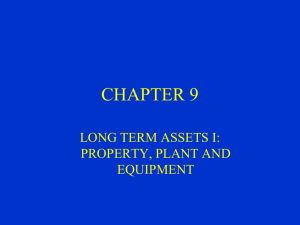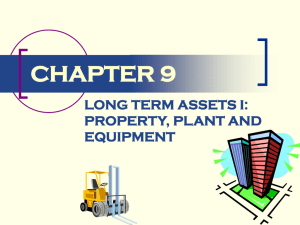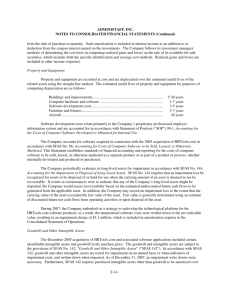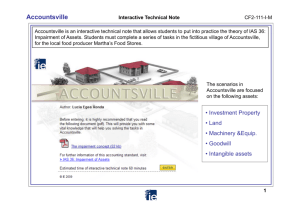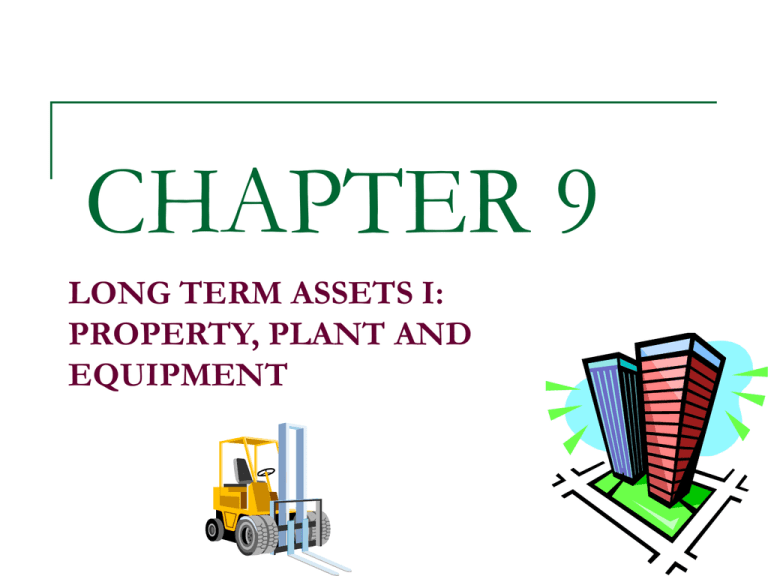
CHAPTER 9
LONG TERM ASSETS I:
PROPERTY, PLANT AND
EQUIPMENT
Property, Plant, and Equipment
Represent a major source
of future service potential
Valuation is important
because
indication of physical
resources available to the firm
and may give some indication
of future liquidity and funds
flow.
Accounting Objectives
1
2
3
4
5
Accounting and reporting to investors on stewardship
Accounting for the use and deterioration of plant and
equipment
Planning for new acquisitions
through budgeting
Supplying information for
taxing authorities
Supplying rate-making
information for
regulated industries
Accounting for Cost
Initial cost: sacrifice of resources given up now to
accomplish future objectives
Preferred measurement technique:
discounted present value of future
receipts
Indicates future services potential
Accounting for Cost
Some problems
Group purchases
Self constructed assets
Removal of existing assets
Non-monetary exchange
Donated or discovery values
Group Purchases
Total acquisition cost must
be allocated to the
individual assets
Usual method:
base the allocation on the
relative fair market values
Self Constructed Assets
What is cost?
Include all incremental costs
Allocation of fixed overhead
None
Incremental
Same basis as other products
Interest
SFAS No 34 issues
The concept of qualified assets
The amount to capitalize
Removal of Existing Assets
Charge removal cost less
proceeds to cost of land
Assets Acquired in Noncash Transactions
APB No. 29
Fair value for most
Book value when the exchange is not the
culmination of the earnings process
Recording gains and losses on
nonmonetary assets with Commercial
substance under SFAS 153
Definition
Record at book value
Donated and Discovery Values
How they occur
Accounting Under AFAS No. 116
Financial Analysis of Property
Plant and Equipment
The impact of PP & E on the return on
assets ratio
Sustainability of earnings
Evaluating a company’s replacement of
assets policy
Financial Analysis
of Property Plant and Equipment
PP&E Acquisitions
(in millions)
200
182
181
150
100
18
50
15
0
2004
Hershey
2005
Tootsie
Financial Analysis of
Property Plant and Equipment
PP&E Acquisitions
(As % of total assets)
6.00%
5.4% 5.6%
5.2%
4.5%
4.00%
2.00%
0.00%
2004
Hershey
2005
Tootsie
Financial Analysis of Property , Plant and
Equipment
The companies’ return on
assets percentages are not
being distorted by a failure to
systematically replace their
long-term assets
Hershey is replacing its assets
over twice as fast as is Tootsie
Cost Allocation
Capitalization implies future
service potential
Matching concept requires
expiration of future service potential to be
recorded in the period incurred
Actual expiration of future service potential difficult
to ascertain
“cost allocation”
method of cost allocation should be systematic and
rational
Depreciation is a form of cost allocation
The Depreciation Process
Issues:
1
2
3
Establishing the proper depreciation
base
Determining useful service life
Choosing a cost allocation method
Straight-line
Accelerated
Units of Activity
Capital Vs. Revenue Expenditures
Whether to capitalize
or charge to expense
expenditures required for an existing
long-term asset
Criteria
Prolong life or increase efficiency
Ordinary and necessary
Capitalize
Expense
Recognition and Measurement Issues
User needs are currently not being satisfied
Suggests a current value approach
Impairment of Value
Long-term asset accounting should be similar to
accounting for other assets
Asset should be written down when value diminishes
SFAS No.121
Impairment occurs when carrying amount is not recoverable
Future cash flows < Book value
Recognize loss when book value is not recoverable
SFAS No. 144: Accounting for the
Impairment or Disposal of Long-Lived Assets
Issued because SFAS No. 121 did not address accounting
for a segment of a business accounted for as a discontinued
operation under APB Opinion 30.
Consequently, two accounting models existed for
long-lived assets to be disposed of.
The Board decided to establish a single accounting model
based on the framework established in SFAS No. 121, for
long-lived assets to be disposed of by sale.
SFAS No. 144: Accounting for the Impairment
or Disposal of Long-Lived Assets
Applies to all dispositions of longterm assets
1.
2.
3.
Excludes current assets, intangibles
and financial instruments because
they are covered in other releases.
According to its provisions assets are
to be classified as:
Long-term assets held and used
Long-lived assets to be disposed of
other than by sale
Long-Lived Assets to Be Disposed Of
by Sale
SFAS No. 144: Accounting for the Impairment
or Disposal of Long-Lived Assets
Long-term assets held and used are to be
tested for impairment using the SFAS No.
121 criteria if events suggest there may
have been an impairment.
The impairment is to be measured at fair
value by using the present value
procedures outlined in SFAC No. 7.
For long-term assets held and used, it
might be necessary to review the original
depreciation policy to determine if the
useful life is still as originally estimated.
SFAS No. 144: Accounting for the Impairment
or Disposal of Long-Lived Assets
Next the assets are grouped at the lowest level for which
identifiable cash flows are independent of cash flows from
other assets and liabilities
Losses are allocated to the assets in the group on a pro-rata
basis.
Any losses are disclosed in income
from continuing operations
SFAS No. 143: Accounting for Asset
Retirement Obligations
Objective: to provide accounting
requirements for all obligations
associated with the removal of long-lived
assets
For each asset retirement obligation
Initially record the fair value (present value) of the liability to
dispose of the asset when a reasonable estimate of its fair value is
available.
Required to use SFAC No. 7 criteria for recognition of the liability
Present value of the asset at the credit adjusted rate.
Defined as the amount a third party with a comparable credit standing
would charge to assume the obligation.
SFAS No. 143: Accounting for Asset
Retirement Obligations
Capitalized asset retirement cost
allocated in a systematic and rational manner
as depreciation expense over the estimated
useful life of the asset.
Initial carrying value of the liability
increased each year by use of the interest
method
using the credit adjusted rate
classified as accretion expense
and not interest expense.
International Accounting Standards
The IASC has issued
pronouncements on the
following issues:
1.
2.
3.
4.
5.
The overall issues associated with accounting for property, plant,
and equipment assets in a revised IAS No. 16, "Property, Plant and
Equipment."
Interest capitalization in IAS No. 23, “Borrowing Costs.
Impairment of Assets in IAS No. 36, “Impairment of Assets.”
Accounting for Investments in Property in IAS No 40, “Investment
Properties.”
The accounting treatment for assets held for disposal in IFRS No.
5, “Non-Current Assets Held for Sale and Discontinued
Operations.”
IAS #16: Property, Plant and Equipment
Revised IAS No. 16 did not change the fundamental
approach to accounting for property plant and
equipment.
Recognize items as assets when economic benefit will flow to
enterprise and cost can be measured
Preference is to depreciate historical cost of assets
Allows revaluations to current market value
Requires recording of impairments
Depreciation charge should reflect pattern
of benefits
If change in pattern of benefits is noted,
change depreciation method to reflect
new pattern
IAS #16: Property, Plant and Equipment
The major clarifications in revised IAS No. 16:
1.
2.
Requiring a components approach for
depreciation
The acquisition cost of property, plant, and
equipment should include
3.
Amount of an IAS 37 provision for the estimated cost
of dismantling and removing the asset and restoring
the site
Include both provisions when the asset is acquired and incremental
provisions recognized while the asset is used
Accounting for incidental revenue (and related expenses) during
construction or development of an asset will depend on
Whether the incidental revenue is a necessary activity in bringing the asset
to the location and
Working condition necessary for it to be capable of operating in the manner
intended by management
IAS #16: Property, Plant and Equipment
4.
5.
Exchanges of similar items of property, plant, and equipment
recorded at fair value
gain or loss will be recognized
Measurement of residual value defined:
the current prices for assets of a similar age
and condition to the estimated age and
condition of the asset when it reaches the end
of its useful life.
unless neither the fair value of the asset given up
nor the fair value of the asset acquired can be
measured reliably
Subsequent expenditure is capitalized
only if the expenditure increases
the asset's future economic benefits above
those reflected in its most recently assessed
level of performance
IAS No. 23: Impairment of
Assets
Requires:
an impairment loss to be recognized on items of property, plant and
equipment
whenever the recoverable amount of an asset is less
than its book value
The recoverable amount is the higher of
asset’s selling price
or value in use (present value of future cash flows)
IAS No. 40: Investment Property
Defined as land or buildings held to
earn rentals or for capital appreciation
May account by either:
Fair value with changes
reflected in income
IFRS No. 5: Non-Current Assets Held for Sale
and Discontinued Operations
Establishes a classification for non-current
assets 'held for sale'
using the same criteria as those contained in US
FASB Statement 144 Accounting for the
Impairment or Disposal of Long-Lived Assets.
Therefore, operations that are expected to
be wound down or abandoned would not
meet the definition
but may be classified as discontinued once
abandoned.
IFRS No. 6: Exploration & Development Assets
Required to be measured initially at cost.
Typical allowable expenditures:
Topographical, geological,
geochemical, and geophysical studies
Exploratory drilling, trenching,
sampling
Prepared by
Kathryn Yarbrough, MBA
Copyright © 2009 John Wiley & Sons, Inc. All rights reserved.
Reproduction or translation of this work beyond that permitted in
Section 117 of the 1976 United States Copyright Act without the
express written consent of the copyright owner is unlawful. Request
for further information should be addressed to the Permissions
Department, John Wiley & Sons, Inc. The purchaser may make backup copies for his/her own use only and not for distribution or
resale. The Publisher assumes no responsibility for errors,
omissions, or damages, caused by the use of these programs or from
the use of the information contained herein.

